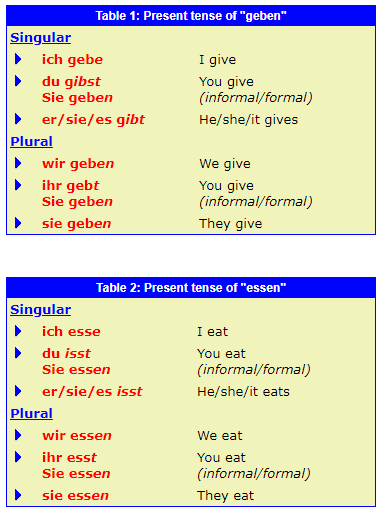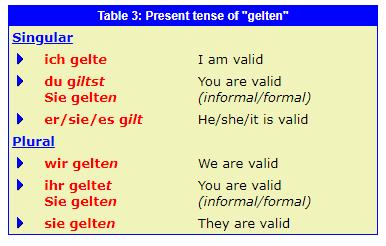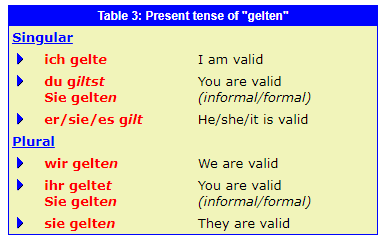Verbs are called irregular or 'strong' if they are conjugated in ways that are different from the normal patterns. Verbs that adhere to these patterns are called regular or 'weak'. These divergences from the standard conjugation patterns include:
vowel changes in the stem of the verb
addition of umlauts in the stem of the verb
consonant changes in the stem of the verb
endings that are different to the standard pattern
There is no way of telling from the infinitive of a verb whether it is weak or strong. Their irregularities need to be learned verb by verb, and it is for this reason that I have supplied the conjugation of the main German strong verbs, which can be accessed by clicking here.
We can say however that the majority of these strong verbs are consistent in that it is only their second and third person singular forms (i.e. the "du" and "er/sie/es" forms) that display irregularities in the present tense. The other forms of the verb have the stem and endings that we would expect to find.
A few patterns can be observed with the irregular forms of the second and third person singular in the present tense.

Verbs that behave this way in the present tense include: bergen (to rescue), bersten (to burst), brechen (to break), dreschen (to thresh), erschrecken (to be startled), essen (to eat), fechten (to fence), flechten (to plait), fressen (to eat (of animals)), geben (to give), gelten (to be valid), helfen (to help), messen (to measure), nehmen (to take), quellen (to gush), schelten (to scold), schmelzen (to melt), schwellen (to swell), sprechen (to speak), stechen (to sting), sterben (to die), treffen (to meet), treten (to step; to kick), verbergen (to hide), verderben (to spoil), vergessen (to forget), werben (to recruit; to advertise), werfen (to throw).
Note in particular the present tense of the verbs in the above group whose infinitive has a stem in -t- (bersten, fechten, flechten, gelten, treten)

Within this sub-group, the verb "treten" (to step, to tread; to kick) not only changes its stem vowel from -e- to -i-, but also doubles the medial -t- in the "du" and "er/sie/es" forms.

 英语
英语 日语
日语 韩语
韩语 法语
法语 西班牙语
西班牙语 意大利语
意大利语 阿拉伯语
阿拉伯语 葡萄牙语
葡萄牙语 越南语
越南语 俄语
俄语 芬兰语
芬兰语 泰语
泰语 丹麦语
丹麦语 对外汉语
对外汉语

